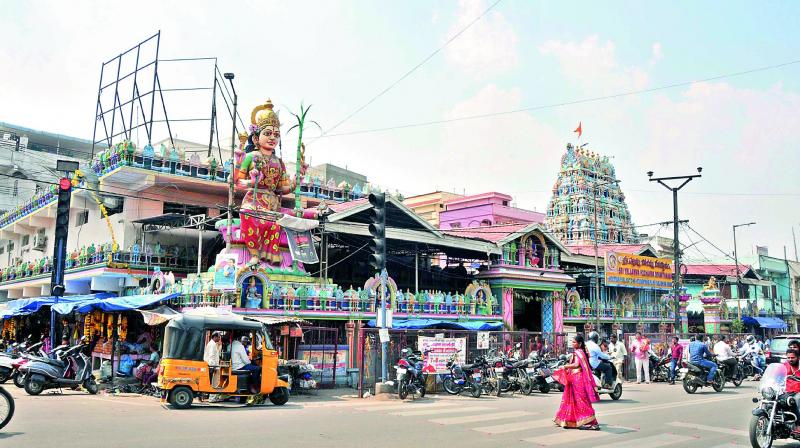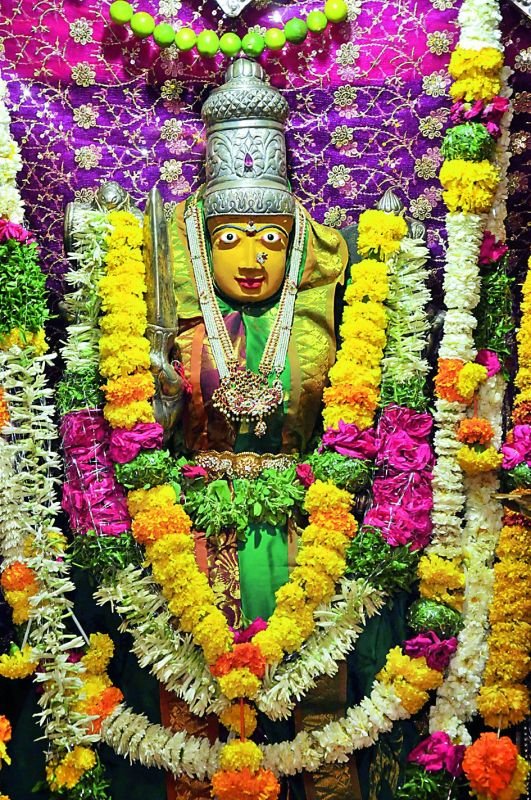Sri Yellamma Pochamma Devasthanam
 Sri Yellamma Pochamma Devasthanam, Balkampet has been constructed in the year 1919. The main Goddess YELLAMMA is said to be Swaymbhu, meaning Self appeared, not installled by humans at ground level. The deity is in the water and un-spontaneously water will flow through springs (Uta) particularly. There is a small temple towards south side which is called as POCHAMMA Devi.
Sri Yellamma Pochamma Devasthanam, Balkampet has been constructed in the year 1919. The main Goddess YELLAMMA is said to be Swaymbhu, meaning Self appeared, not installled by humans at ground level. The deity is in the water and un-spontaneously water will flow through springs (Uta) particularly. There is a small temple towards south side which is called as POCHAMMA Devi.  The two important festivals in this temple are Ammavvari “KALYANAM” and “BONALU” which is being celebrated every year. Important days of of worshipping the Goddess are Sunday, Tuesday and Thursday respectively.
The two important festivals in this temple are Ammavvari “KALYANAM” and “BONALU” which is being celebrated every year. Important days of of worshipping the Goddess are Sunday, Tuesday and Thursday respectively.
This temple was stated to has been constructed during the regime of H.E.H, the Nizam of Hyderabad. As per the version of the local people there lived a Jagirdar called Sri Raja Shivaaraj Bahadur who ruled the present temple area which was called at the time as “Behlool Khan Guda” and now this locality is called as BALKAMPET.
The pilgrims are mostly lower and middle class people and mainly the devotees from twin cities visiting this temple. The annual festival takes place in the month of July every year and Ammavari (Renuka or Yellamma) Kalyanam will be celebrated in the month of July or August every year. During the festival celebrations devotees will congregate in large scale.
A Naga Devatha Temple was also constructed in the year 1993 and Ganapathi Temple was also constructed in the month of April-2012. Kumabhisekham was performed on 06.02.2011 by Kanchikamakoti Peetadhipati Sri Sri Jayendra Saraswathi Swamyvaru and New Dwajasthamba Pratistha on 15.04.2012 by Pushpagiri Peetadhipathi Sri Sri Madabhinavoddanda Vidhya Nrushima Bharathi Swamyvaru and Visakha Sarada Peetadhipathi Sri Sri Swaroopanandendra Swamyvaru and a Addala Mandapam was also established on 15.04.2012 and Sri Raja Rajeswari Statue at the height of 29 Feet at south corner of Temple was also established on Kalyanotsavam on 26.06.2012.
This temple was initially registered in the year 1963 by the Director of Endowments and Joint Secretary, Board of Revenue, Kingkoti, Hyderabad vide Reg.No.1341, Dt.04.07.1963 U/s old Act 19/1951 and later reclassified and published u/s 6(a)(ii) and Registered U/s 43(10) of the Act 30/87 vide Lr.No.D/1283/2012, Dt.30.07.2012.
Now, this Devasthanam is being managed by the Executive Officer in the cadre of Assistant Commissioner under administrative control of the Commissioner, Endowments Department, T.S., Hyderabad.
Article from Deccan Chronicle
DECCAN CHRONICLE. | LALITA IYER
Published Apr 8, 2018, 12:57 am IST
Jala Durga at Balkampet fulfills all your desires

Yellamma Temple is at Balkampet and is also known as Renukadevi temple and is believed to have been here since the 15th century.
The Yellamma temple at Balkampet. It has been here since 15th century. There is a strong belief that the water from here has curative powers and so people carry it in bottles and mix with regular water for bathing. (Photo: P. Surendra)
HYDERABAD: The legends related to Yellamma Temple are so old that there is neither anyone who remembers nor there is any provenance to tell us whether there is any truth in those stories. But, then again, faith moves mountains. The current priest Goosaganti Balakrishna Sharma, who has been here since 1986, says that he has seen a lot of wishes getting fulfilled and people going away happily from here. Yellamma Temple is at Balkampet and is also known as Renukadevi temple and is believed to have been here since the 15th century. Since the Goddess lies in water, she is also aptly called Jala Durga.
Probably this gem was hidden in the agricultural fields and surrounding greenery, in a small village, when it was not part of the city while development in these parts was a far cry. Farmers and people living in the village dug a well for water and as per the legend, they found a rock with the sculpture of a Goddess engraved on it.  It is said that the villagers tried to move the rock in order to dig a well for the purpose of farming, but the stone was immovable and so after trying for a long time, the villagers decided not to move the rock and planned to construct a small temple around the icon itself.
It is said that the villagers tried to move the rock in order to dig a well for the purpose of farming, but the stone was immovable and so after trying for a long time, the villagers decided not to move the rock and planned to construct a small temple around the icon itself.
Goddess Yellamma lying gloriously, clad in gold and decorated lovingly and embellished with jewellery, flowers, KumKum etc.
Now, there is a strong belief that the water from here has curative powers and so people carry it in bottles and mix with regular water for bathing. “In fact, it is very helpful for chicken pox and other skin diseases,” says the head priest. Many, who come here to pray to the Goddess, are ardent devotees. The priest always assures that there is always water there and the Goddess is clad in the gold ‘Kavacham’. The temple is now popular as Ammavari Temple. It is crowded on all days with people thronging the place with vows and wishes to be fulfilled. “In fact, there were so many ‘mudis’ (bundles filled with coconut and of course the unfulfilled wish) that it got crowded on top and so we have given a separate place to keep them,” the priest said.
People come with all kinds of wishes, including for children, weddings, exam results and many more wishes. “Ammavari is all powerful and grants all your wishes. Since she is a Swayambhu avatar she has no yantra or Tantra,” the priest said. The Balkampet then and now is a living example of brisk development, with no care given to space or design. In fact residential spaces around the temple look crowded. This temple was taken over by the Endowments Department in 1978.
Since it is in the heart of the commercial centre, attempts were made to find out the source of the water which flows from the head side of the Mother Goddess. Then an attempt was made to change the course of the water and even that could not be done. So the next best thing to do was to set up a pump and allow the water to flow continuously and allow people to use its curative powers.  Special poojas draw lakhs of people every day and though the priest says that only Sundays, Tuesdays and Fridays are very busy days at the temple, the crowd on other days belie that statement.
Special poojas draw lakhs of people every day and though the priest says that only Sundays, Tuesdays and Fridays are very busy days at the temple, the crowd on other days belie that statement.
Goddess Pochamma.
The annual Bonalu Jatara is very famous and eagerly awaited by the people. Here, mother goddess Yellamma is also called as Goddess Renuka. There is a legend associated with this temple. Renuka, the daughter of Raja Renuka, had married Jamadagni, the son of Satyawati and had five sons, one of them being Parashurama. Legend says that one day, Renuka couldn’t perform one of her regular household chores and this enraged her husband who then asked her to leave the house. Dejected Renuka was roaming around the forest when saints suggested her to perform pooja near a Shivalinga and feed Brahmins as a penance.
Jamadagni continued to be furious at her and demanded his sons to punish their mother Renuka. All others refused and they were burnt to ashes by the father’s gaze but Parashurama hunted for his mother, who was hiding in a village, and beheaded her, along with a woman who was helping her. Jamadagni was pleased by his son’s obedience and gave him a boon and in turn Parashurama asked his father to restore the lives of his brothers, his mother and the village woman. However, during the process, an exchange happened and the head of Renuka was restored on the other woman’s head and vice versa.
While Jamadagni accepted the woman who had Renuka’s body, the other form came to be popularly known as Yellamma, meaning mother to all. This probably is one of the few temples where sacrifice is still allowed. Since Goddess Yellamma is also considered as an incarnation of Goddess Kali, devotees offer animal sacrifice here. The most important event here is the Yellamma Kalyanotsavam, Bonalu Jathara and this jatara happens after the Golkonda jatara each year. The temple also has dedicated shrines to many other Gods and Goddesses such as Ganesha, Nagadevta, Rajarajeshwari, and Sri Pochamma.
Stepping down a few steps to worship the main icon, you can see Goddess Yellamma lying gloriously, clad in gold and decorated lovingly and embellished with jewellery, flowers, KumKum etc. This is a beautiful sight. This glorious view is 10 feet lower than the ground-level and the holy water here is treated as ‘teertham’ and is said to have curative powers. There is an Akhand Jyoti which was lit during the temple renovation period.
Yellamma is also the incarnation of Maa Kali, and so the Akhand Jyothi was lit within the sanctum sanctorum by Sri Virupaksha Shankaracharya Swamy and has been there since the renovation of the temple in 1983. Ammavari Yellamma is also known as Bala Tripura Sundari and is considered to be the Kaliyuga avatar of Sri Chinna Mastha Devi. So, crowd or not, this location is a busy one and the temple doors are open all the while with the Mother Goddess lying cool in her water bath, ready to grant all your wishes. Famous persons visit this temple. The latest was Reliance chairperson Nita Ambani.
